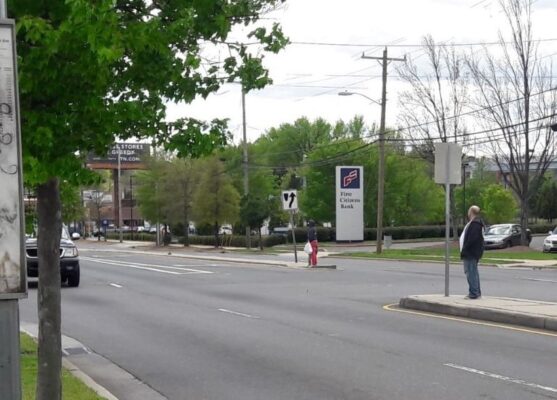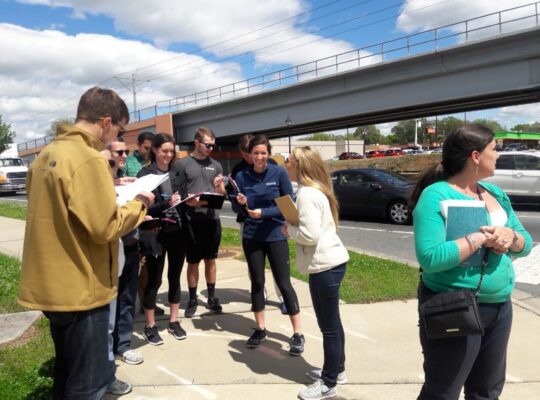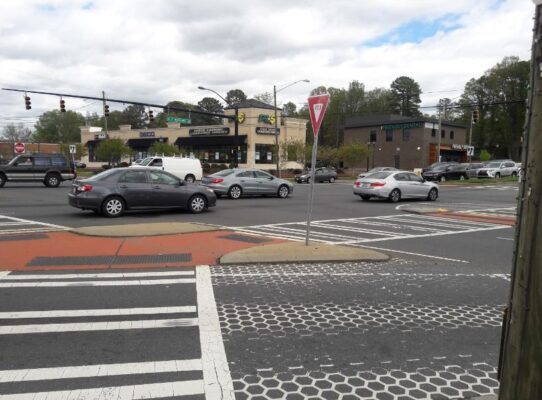Walk2Transit volunteers hit the streets for better bus stops
Watch a clip of our Walk2Transit volunteers sharing their thoughts after our walkability tour.
44 new residents per day are joining Charlotte’s rapidly growing population. But in spite of that growth, CATS bus ridership is declining. Why aren’t more people choosing transit? A major reason identified by CATS CEO John Lewis is that the timing, frequency, and coverage of the current bus network isn’t meeting the needs of riders. CATS’ Envision My Ride initiative will address that problem through a major bus network redesign process, which we’re keeping you updated on. Check out the first round of changesproposed for June.
Where are all the bus riders?
But what about the experience of bus riders as they walk to and from stops? Sustain Charlotte’s Walk2Transit project is an 18-month effort to identify, evaluate, and advocate for improvements to bus stops that are tough to walk to.
About 80% of daily transit trips in Charlotte are taken by CATS bus. Yet thousands of riders have a hard time getting to and from their bus stops because of sidewalk gaps, too few street crossings, and other barriers.
And how many people don’t even try to ride the bus because they don’t want to face an uncomfortable experience either getting to the bus stop or waiting there?
After collecting lots of public input and suggestions of bus stops that need some attention, we have organized a series of walkability audits for the highest need areas. With the help of 8 awesome volunteers from Protiviti during EarthShareNC’s Corporate Challenge, we documented conditions for transit riders around the Tyvola LYNX light rail station and bus stops on the opposite side of South Boulevard. It’s an area with high transit ridership, but also lots of challenges for walking.

We saw a man and a woman with a child trying to cross South Boulevard with no marked crosswalk.
Gathering valuable data and insights

Our volunteers took notes on walkability conditions for bus riders.
Each volunteer answered questions on a customized audit form. Most of the questions just involved circling a “1 to 5” ranking or Yes/No options, but we also included lots of open-ended questions so the volunteers could share their observations and ideas.
Some of the volunteers were regular riders of transit, but some were not. The diversity in transit experience among our volunteers means we’re collecting information about both rider and non-rider perceptions of the pedestrian experience. At the end of the walking audit, we asked the volunteers:
- Was today’s experience what you expected? If not, how did it differ from your expectations?
- If you’re not currently a regular bus rider, what would have to change for you to try riding?
Peeling back the layers
A recurring theme of conversation among the volunteers was a growing sense of empathy for bus riders as our walk progressed. They saw people “jay-walking” because there was no marked or signalized crosswalk within a reasonable walking distance between their stop and destination. They saw pedestrian crossing signals that changed a little too quickly to cross comfortably. They saw impatient drivers not yielding to our group.
As one volunteer said, “I normally drive when I commute, so it was interesting kind of taking on the perspective of someone that has to walk all the time and how scary that can be.”
Focusing on solutions
Although we’re documenting challenges faced by riders, the focus is on moving forward to a better bus system that fully meets the needs of its current riders and attracts new ones. In addition to documenting problems, we’re also asking volunteers to share their ideas for improvement and noting what IS working well on the streets.
On this first audit, they noticed the benefits provided by sidewalks separated from traffic by a planting strip (in some areas), textured accessibility ramps at all bus stops, and pedestrian refuge islands at some street crossings.

Volunteers loved the pedestrian refuges at the Woodlawn Rd & South Blvd intersection!
Sustain Charlotte will compile all of the data from the walkability audits and share it with city transportation staff to determine which needed improvements can be made within their existing scope of operations and budget. For larger needs identified by the project, we’ll organize advocacy efforts to make elected officials aware of the urgent need for funding to make our highest-need bus stops accessible to all people.
We’re just getting started! Can you help us?
Sign up today to volunteer for one of our walking audits! We have them all over Charlotte on various dates. This is an all ages and abilities activity. Families are welcome, but kids must be closely supervised by a parent/guardian since we’ll be walking along busy streets. Audits will be rescheduled if it rains.
CLICK HERE or on the map below to sign up for a walking audit today! From each point on the map, you can click through to each tour’s unique ‘Sign Up Genius’ to see details about meeting location, length, and how to register.
If you’d like to bring a larger group or coordinate an alternate time/date for your neighborhood association, workplace, or other organization, we’d love to accommodate you! Email meg.fencil@sustaincharlotte.org for more info.
We’re still finalizing a few more walking audits including at least one in northeast Charlotte, so stay tuned!
The Walk2Transit project is funded by a grant from TransitCenter. Learn more about the project’s goals, scope, and progress at www.sustaincharlotte.org/walk2transit.
Thanks for reading!
As a nonprofit, community support is essential for us to keep doing what we do — including providing free articles like this. If you found this article helpful, please consider supporting Sustain Charlotte.
Want to stay in the loop? Subscribe to our weekly newsletter and follow us on Instagram, Facebook, and Twitter.

